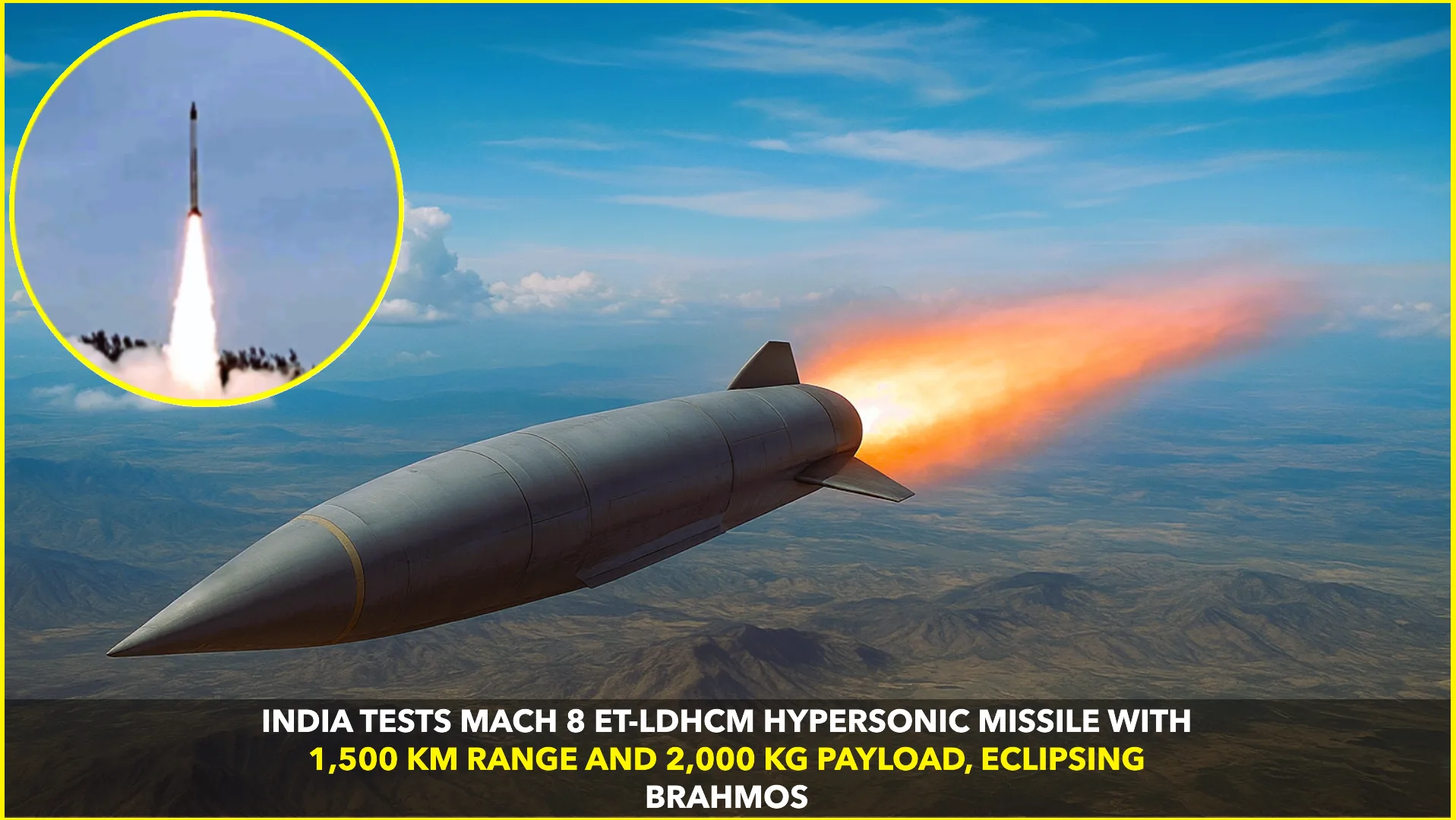India has reportedly achieved a breakthrough in missile technology by successfully test-firing its home-grown Extended Trajectory-Long Duration Hypersonic Cruise Missile (ET-LDHCM). Developed under DRDO’s classified Project Vishnu, this missile reportedly flies at Mach 8 (eight times the speed of sound) and covers distances of up to 1,500 km, greatly surpassing the capabilities of the current BrahMos missile The Economic Times+2Wikipedia+2.
The Test and Its Significance
Between July 14 and 16, 2025, DRDO conducted successful trials from a test range on India’s eastern coast. The missile followed its planned trajectory and hit designated targets with high precision. Observers note that ET-LDHCM endured extreme aerodynamic heating—up to 2,000 °C—while maintaining stability at hypersonic speeds Wikipedia+2The Economic Times+2. That thermal resilience is attributed to specially developed heat-resistant materials and oxidation-resistant coatings applied to its airframe Wikipedia+2Defence Industry Europe+2.
Powering Hypersonic Speed
Crucial to its performance is the scramjet engine, which draws oxygen directly from the atmosphere rather than carrying onboard oxidizer. This air-breathing approach keeps the missile lighter and supports sustained flight at Mach 8 or more (approximately 11,000 km/h) Wikipedia+2NextGen Defense+2.
In a related 1,000-second ground test conducted in November 2024, the scramjet combustor demonstrated reliable ignition and stable combustion under high stress—vital proof of readiness for flight trials Wikipedia+1.
Payload and Stealth Tactics
Designed to carry 1,000 to 2,000 kg of either conventional or nuclear warheads, ET-LDHCM can strike deeply into hostile territory. In contrast, BrahMos remains limited to Mach 3 speeds and roughly 450 km range. ET-LDHCM thus represents a dramatic leap in speed, reach, and impact Wikipedia+2The Economic Times+2.
The missile also employs low-altitude flight and mid-course maneuverability, which complicates interception by existing air-defense systems. Furthermore, at hypersonic velocities, ionized air around the missile generates a plasma sheath that can absorb radar signals, reducing radar visibility and enhancing stealth Army Recognition+2EURASIAN TIMES+2.
Flexibility in Launch Platforms
ET-LDHCM is engineered to be launched from land, sea, or air platforms. Compatibility with aircraft such as the Su-30MKI and Rafale adds operational versatility across India’s armed forces The Economic Times+2Defence Industry Europe+2. Payload targeting systems likely integrate inertial guidance supplemented by satellite navigation (e.g. NavIC or GPS) to improve accuracy.
Strategic Implications
With this test, India joins a select group of nations—such as the U.S., Russia, and China—with indigenous hypersonic cruise missile capability The Economic Times+2Defence Industry Europe+2. Analysts suggest that the missile’s speed, stealth, and maneuverability could allow it to defeat advanced defense systems like Israel’s Iron Dome, Russia’s S-500 or U.S. THAAD The Economic Times+2The Economic Times+2.
It sends a clear message of strategic deterrence. With tensions rising across the Indo-Asia region, especially involving Pakistan and China, India’s ability to strike swiftly and penetrate dense air defense networks reinforces its regional posture.
Project Vishnu: Vision and Roadmap
ET-LDHCM is one of twelve distinct hypersonic systems under Project Vishnu, which aims to create both offensive cruise missiles and interceptors. Earlier, DRDO tested the Hypersonic Technology Demonstrator Vehicle (HSTDV), which achieved Mach 5 sustained flight and laid the foundations for current developments Wikipedia+1.
Deployment expectations place ET-LDHCM operational by 2030, following rigorous testing phases focused on electronic counter-measure resistance, flight accuracy, and multi-platform integration Wikipedia+2The Economic Times+2.
Technology and Industry Impact
Beyond battlefield uses, the rocket-science behind ET-LDHCM—scramjet engines, high-temperature materials, aerodynamic control systems—holds promise for civilian aerospace applications, including faster satellite launches and hypersonic transport. The program also supports India’s self-reliance goals, involving SMEs and private contractors in cutting-edge defense manufacturing Wikipedia+3Wikipedia+3The Economic Times+3.
While some reports hint that official funding from India’s Ministry of Defence remains pending, most credible sources—including Economic Times, Defence Industry Europe, and The Defense Post—indicate the missile test has already taken place and DRDO is in advanced stages of development Indian Defence Research Wing+2Defence Industry Europe+2.
In sum, ET-LDHCM marks a pivotal step in India’s missile evolution—outpacing BrahMos across all metrics, staking claim to indigenous hypersonic technology, and reshaping deterrence in the region.










